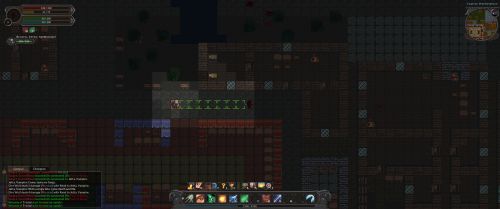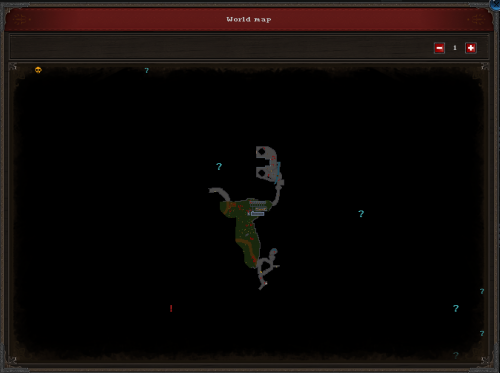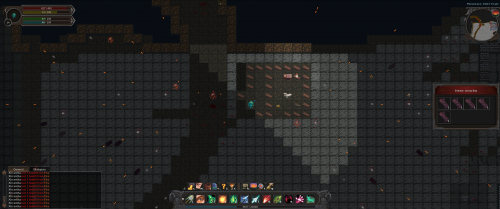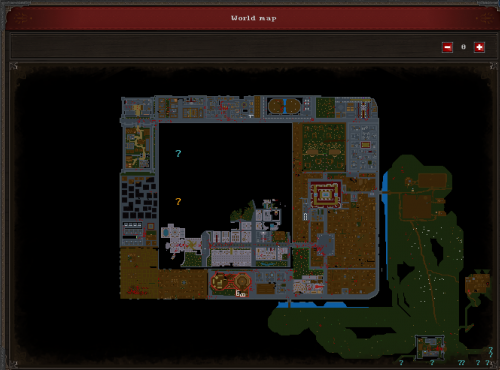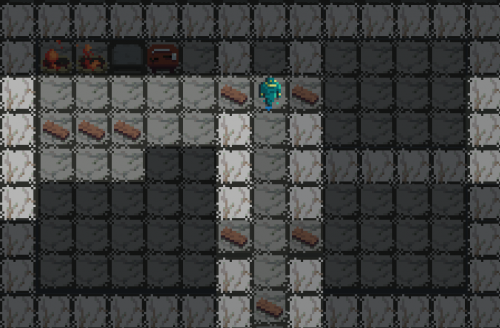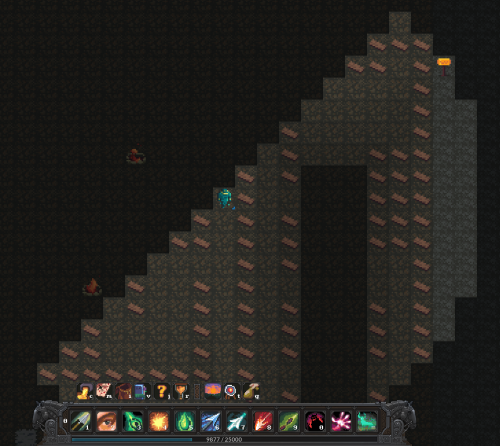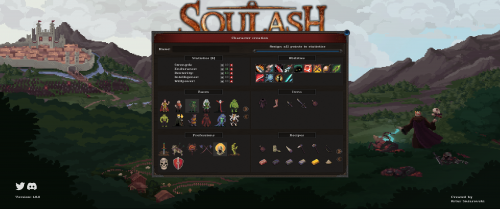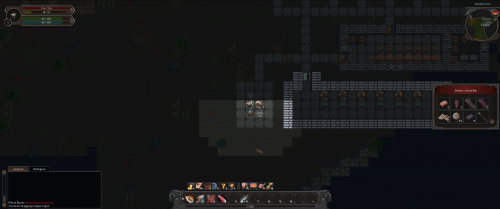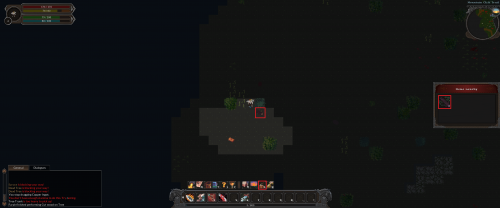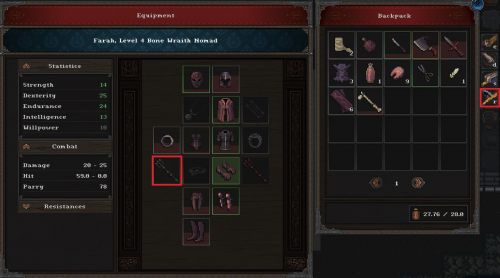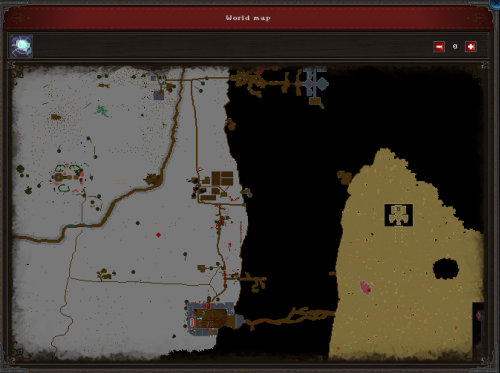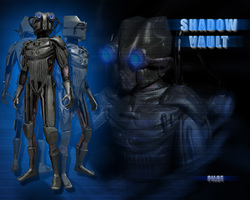RPG Codex Review: Soulash
RPG Codex Review: Soulash
Codex Review - posted by Darth Roxor on Fri 13 May 2022, 18:10:12
Tags: SoulashAnother day, another Codex review of another game you may have never heard about. Or may at least know nothing about. I know I did before reading this in-depth analysis of Soulash by community member Lukaszek.
I'm not exactly an aficionado of roguelikes, so I don't even know what to put here. Instead, I'll just let the text speak for itself.
Artifact-wielding yokels are definitely a part of my definition of 'fun'. The article also examines the game's crafting system, world-building, general gameplay paradigms and the ecological repercussions of devouring gods responsible for certain aspects of the natural order. Read on here: RPG Codex Review: Soulash
I'm not exactly an aficionado of roguelikes, so I don't even know what to put here. Instead, I'll just let the text speak for itself.
Eventually you learn the ropes and start exploring. The world is handmade and general directions stay the same during each playthrough. Based on your seed, some settlements might look a bit different or enemies in a given area will change slightly. The same settlement might be a farmer village in one run, while in another you’ll only find burned down houses and orcs there. The next time, you find the buildings intact, but all the villagers have turned into zombies.
While this can make planning a bit harder, it’s nothing truly major. You might find some weak troglodytes with decent spears in one of the caves. You return there in the next life, hoping to loot their weapons, only to find bugs instead. It will hamper your early game if you were set on using spears, but you’ll obtain decent weapons soon enough.
There is one random factor that can easily kill you if you don’t pay attention. Every piece of equipment, be it crafted or generated in the world (on enemies), can be upgraded into an artifact. That scythe-swinging peasant can poke quite a hole in your body when he spawns with a unique spear.
There is no mechanic that will make you stronger on subsequent runs. There are no unlockables, secret powers or anything of that sort. The only difference is that during character creation, the game will show the talents that a given class can learn at the appropriate levels, provided you’ve reached that level first yourself. If anything, I found that obfuscation annoying, although it can be easily fixed if you navigate to your data files. In general, the configs aren’t hidden and the game seems easy to mod.
With the world being same-ish with each run, you become stronger only by not repeating the same mistakes. Though it can be annoying if your mistake was being ambushed by an enemy with some nasty artifact. In general, you’ll learn to run into more newbie-friendly areas. There you’ll establish a base with food, water and a bed, and then proceed to clear out nearby enemies so that your beauty sleep won’t be interrupted. Those sleeping in the woods usually get ambushed.
While this can make planning a bit harder, it’s nothing truly major. You might find some weak troglodytes with decent spears in one of the caves. You return there in the next life, hoping to loot their weapons, only to find bugs instead. It will hamper your early game if you were set on using spears, but you’ll obtain decent weapons soon enough.
There is one random factor that can easily kill you if you don’t pay attention. Every piece of equipment, be it crafted or generated in the world (on enemies), can be upgraded into an artifact. That scythe-swinging peasant can poke quite a hole in your body when he spawns with a unique spear.
There is no mechanic that will make you stronger on subsequent runs. There are no unlockables, secret powers or anything of that sort. The only difference is that during character creation, the game will show the talents that a given class can learn at the appropriate levels, provided you’ve reached that level first yourself. If anything, I found that obfuscation annoying, although it can be easily fixed if you navigate to your data files. In general, the configs aren’t hidden and the game seems easy to mod.
With the world being same-ish with each run, you become stronger only by not repeating the same mistakes. Though it can be annoying if your mistake was being ambushed by an enemy with some nasty artifact. In general, you’ll learn to run into more newbie-friendly areas. There you’ll establish a base with food, water and a bed, and then proceed to clear out nearby enemies so that your beauty sleep won’t be interrupted. Those sleeping in the woods usually get ambushed.
Artifact-wielding yokels are definitely a part of my definition of 'fun'. The article also examines the game's crafting system, world-building, general gameplay paradigms and the ecological repercussions of devouring gods responsible for certain aspects of the natural order. Read on here: RPG Codex Review: Soulash
[Review by Lukaszek]
A game where you are set to destroy the world for a change. No longer a farm boy in the middle of nowhere, slowly gaining power – you’re instead a forgotten god called the Devourer, willing to destroy everything to gain your power back (a completely different thing!).
To fit such a vision of grandeur, the starting options include a lich necromancer, a vampire fallen knight, a golem eating enemy equipment and many more. There is something for everyone here, although you can’t be a dragon. Scalies can pick a lizard person instead.
As such, I decided that a goblin poacher would suit me best in my journey to understand the game mechanics. Equipped with a bitten-off human leg that I could barely swing around, the start wasn’t easy.
Tl;dr; the game is quite fun at the beginning but will turn into a chore sooner or later. I will not attempt to keep this spoiler-friendly, so if you wish to jump in blind, stop reading now.
The game won’t disappoint you with yet another checklist of systems. In Goulash, everything works well together and becomes something more than the mere sum of its parts. And a single-dev studio doesn’t have too many cooks to spoil the stew.
The first steps are the hardest
Let’s first look at my equipment – 20 arrows, a meh bow, a broken sword, a chomped-off human leg. The first enemy I find is an orc. I barely survive (mainly thanks to starting with arrows and at some distance away). I encounter another orc – I die.
Start again. Bears. Running away it is. Find a settlement of human farmers. Begin the genocide. Stop the genocide after 3 farmers with little hp left. Find a place to sleep and regain some hp. A wandering orc finds me.
Another start, some cave with weak enemies. Looks promising! Start shooting those arrows. You keep running while shooting those arrows. At some point you notice that your bow broke. You start fiddling with the crafting menu and learn that you need to find an axe and chop down some trees to get another bow. You switch to a pitchfork grabbed from some peasant and hope to find an axe. But you don’t. Change of plans – let’s find some rocks to craft a makeshift axe. You can’t find enough. Starvation starts to kick in – without both an axe and a knife to butcher animals, obtaining food is
Then you git gud. Or give up
Eventually you learn the ropes and start exploring. The world is handmade and general directions stay the same during each playthrough. Based on your seed, some settlements might look a bit different or enemies in a given area will change slightly. The same settlement might be a farmer village in one run, while in another you’ll only find burned down houses and orcs there. The next time, you find the buildings intact, but all the villagers have turned into zombies.
While this can make planning a bit harder, it’s nothing truly major. You might find some weak troglodytes with decent spears in one of the caves. You return there in the next life, hoping to loot their weapons, only to find bugs instead. It will hamper your early game if you were set on using spears, but you’ll obtain decent weapons soon enough.
There is one random factor that can easily kill you if you don’t pay attention. Every piece of equipment, be it crafted or generated in the world (on enemies), can be upgraded into an artifact. That scythe-swinging peasant can poke quite a hole in your body when he spawns with a unique spear.
There is no mechanic that will make you stronger on subsequent runs. There are no unlockables, secret powers or anything of that sort. The only difference is that during character creation, the game will show the talents that a given class can learn at the appropriate levels, provided you’ve reached that level first yourself. If anything, I found that obfuscation annoying, although it can be easily fixed if you navigate to your data files. In general, the configs aren’t hidden and the game seems easy to mod.
With the world being same-ish with each run, you become stronger only by not repeating the same mistakes. Though it can be annoying if your mistake was being ambushed by an enemy with some nasty artifact. In general, you’ll learn to run into more newbie-friendly areas. There you’ll establish a base with food, water and a bed, and then proceed to clear out nearby enemies so that your beauty sleep won’t be interrupted. Those sleeping in the woods usually get ambushed.
Some classes have it easier when assessing danger and potentially running away. When walking through terrains like woods, your LoS will be quite spotty, making it easy to get ambushed – though it’s probably too strong a word, since it might be more about them bumping into you. In general, only low-level enemies are slower than you. Otherwise, shaking enemies off by simply running away is not going to work. If anything, you’ll only exhaust yourself. Some classes have movement skills that allow you to dash a few tiles or receive a temporary speed boost. Others are less lucky and need to improvise: by trying to find obstacles to break the enemy LoS, preferably under the cover of darkness. You can also get creative in ways that involve owning an artifact spear that can summon trees in a given tile. At worst it will break LoS, at best completely block the passage.
Archers will likely be the main issue as you play. Apart from being equipped with long-range bows, they seem to have high intelligence, which consequently gives them quite distant vision. Losing them is nearly impossible and their attacks pack a real punch. Run into one using an artifact bow and it will be game over in most cases. I succeeded in one of my playthroughs by using a unique ability that enables shooting through walls.
Archer god was the enemy that gave me the most trouble in the entire game too.
The player’s map view is serviceable but too tiny to let you spot details like iron ore veins. Its main utility is showing what’s left to explore. Those various markers in the picture are larger souls that you can sense, and in general they wait to be discovered in settlements.
Crafting
Items, especially weapons, break at an annoyingly fast rate. In the beginning, a single weapon won’t last through a whole cave or a small settlement. In your early journey, you’ll constantly discard broken toys and pick up new ones. Eventually, you’ll find a grindstone that allows repairing stuff. Besides water sources, those will be your most important points of interest. The problem is that repairing an item removes 10 max durability. Durability appears to be lost on regular attacks, and the type of the weapon doesn’t matter much here. If you like dual-wielding daggers, here’s some bad news for you – besides being the fastest to attack, they also have the lowest durability and thus break frequently. Since repairing further reduces their max durability, they will break even faster and in general won’t last you very long. Even after crafting the best daggers, I was still reluctant to equip them due to how quickly they would break.
But there is one weapon that’s even more annoying to use – the bow. Apart from the bow itself breaking (and starting ones are quite garbage), arrows have a chance to break at impact as well. Some skills also consume ammunition permanently. While adventuring, you’ll have to take a break often to replenish your ammo supply. Not to mention repair your spare bows. I’d probably carry like 3 bows and 60 arrows before starting an adventure – and those weigh quite a lot, meaning that if you’re a dexterity-based poacher, you’ll have to sink a significant bunch of points into strength just to be able to carry your essential equipment around. I’ll cover the base stats later, but suffice to say – an orc berserker is considered the easiest to play, due to the fact that you’ll have a lot of strength to carry items around, and these also have higher durability.
Most items require a tool to craft. For example, an axe is required to craft arrows. This means that a standard poacher will always carry an axe around to chop down some trees and replenish ammo. Oh, and such an action will break your tool eventually too! A hatchet will be done for after chopping down four trees for wood and turning them into arrows. Higher-grade equipment will also require finding a workstation in the world – think hammer and anvil to forge a sword. You can grab a pickaxe to mine ore, which is then smelted in a smelter and used in the appropriate recipes.
The whole layer of foraging, mining, resource gathering, crafting and surviving feels like playing Minecraft at times. Honestly, the main difference is that you can’t look up a wiki and craft something unknown to your character. Recipes are obtained in two ways. The first is to find one somewhere in the world – which is random, and I can confirm that not every item will have a recipe spawn. The alternative is to salvage an existing item for a chance of learning how to make it and to gain some resources back. The chance of success depends on your intelligence. The base chance is 5%, and each subsequent dismantle adds another 5. This means that by constantly dismantling an item, you’ll eventually learn how to make it. Still, some jewelry is rare enough that you’re unlikely to learn its recipe by dismantling. For example, the best amulet in the game exists in 2-3 copies, so without high intelligence you shouldn’t even attempt to learn crafting it.
Most resources in the game can be obtained easily. For example, I mined 500 gold ore in a single mine. It was enough for me to craft the best-class jewelry and armor without having to smelt all of it. Others can be harder. If you’re into wizard staff crafting, most resources will come only from dismantling other staves.
Crafting is not optional in this game. You won’t venture far if you don’t craft a goatskin flask to carry water with you or prepare rations by butchering animals and cooking their meat. Weapons seem easier for casters or STR-based characters, but if you are DEX-based, crafting weapon replacements is mandatory in my experience. You might get lucky and obtain an artifact weapon with higher durability but even that won’t last you long. In the mid game, you’ll be constantly crafting and discarding mid-tier weapons.
If you’re persistent enough, you’ll reach the end game, when all the items everywhere suffer a permanent durability loss, while you get to craft unbreakable stuff. At that point, you’ll spend several hours (not exaggerating) to replace every piece of equipment that you’re wearing. This is the moment when all that salvaging through the game will pay off and when you’ll finally be able to stab with dual daggers. Sadly, arrows will still break, although not having to worry about hatchet and bow repairs is a huge improvement.
When it comes to resource gathering, a lot of detail was put into certain areas while neglecting others. If you want to acquire some wood, you’ll first have to cut down a tree and get a tree trunk. Cut it again to remove the branches and receive a log. Cut the log again to finally obtain the wood resource. Redundant actions that quickly turn into a tedious experience are sadly quite common here.
While so much detail was put into woodcutting, dealing with animal carcasses left me scratching my head. You can either butcher an animal or skin it. For whatever reason, you can’t do both, as any of these two actions will remove the corpse. Skinning is allowed only on animals with skin, fur or some interesting shell. Meanwhile butchering can be performed on every living being, although humans and other sentient races will not produce meat – only bones. Meanwhile a butchered deer will leave you with no bones. I’d expect a poacher to be able to use an animal fully, gaining all the stuff to use, fur, meat and bones included. Especially in a game where chopping wood is so involved. There must be some clear woodcutting industry agenda at play.
Speaking of wood, it has a few higher-tier variants: maple, aspen, oak and enchanted elven. The first two you’ll eventually find in the world, since those trees are quite distinctive. Oaks are not and they are confined to a single area. I only found them when I was finishing my run. Elven wood I found only by dismantling certain bows and staves.
Each item you craft can be upgraded to better rarity during creation. The order is white < green < blue < purple < yellow. Yellow items are artifacts, but they are not unique. Any base item can become an artifact and gain some special bonuses while retaining the basic specifics. This means that if you want an artifact spear, you can choose between one- or two-handed, attack speed and base damage factors. The upgrade chance depends on intelligence. You can find all the artifacts/upgrades in the game files or the wiki. The success chance formula was also shared by the dev. This whole open approach is quite in opposition to a certain Serbian RPG. Also, the reason why you’ll spend so much time crafting during the end game is because you’ll be forging 30 rings to obtain an artifact among them. Rinse and repeat per each item slot. Depending on luck and intelligence, the numbers may vary.
Crafting is focused on equipment. There is no higher-grade/tier food to cook. There are a few potions but no health ones, and in general I didn’t find them that useful. There are poisons and throwable flasks, but their usefulness is questionable, which will become apparent later on.
World building
Regardless of the seed, your run will start close to the center of the map, near the mountains in the east. I like to think that they act as a natural barrier to the spread of sand and undead on the other side – it works sort of like with chaos in Warhammer. While in every other direction, difficulty will be rising gradually, only death awaits you in the sands.
As you explore the world you can expect to find standard enemies in the appropriate areas. Under the mountains, you will find dwarves. Go deep down their mines and you might find some abandoned settlement of theirs, taken over by goblins.
The great desert holds trolls, nomads and undead like mummies and vampires. Oh, there is a great black pyramid too.
Most of the map is populated with forests that hide animals, amazons and obviously some hidden elven settlements. The elves of this world have fully embraced their feminine nature and even males run around in high heels and beautiful dresses. Those boots are quite nice, so you might be left with an agonizing choice: good stats vs keeping your alpha male Devourer god status.
The world does set the right expectations. An abandoned church with some underground area? It’s likely to have undead that aren’t very resistant to holy damage.
The towns you find are just right, with a few houses and vast farmlands.
As you gain levels, your character will engage in a monologue. It’s the main source for understanding the lore and history of the world. Some things can be learnt when the Devourer battles gods and certain other strong beings.
It turns out, you sired two children using your own essence – a daughter and a son. Before that, there was only you. At one point your children decided to take over and imprisoned you through trickery. They wanted to create the world. Since they couldn’t do it on their own, they utilized your imprisoned essence. Thus, new gods were born and they in turn populated the world depending on their aspects. For example, the mountain god created… mountains and dwarves.
Your children didn’t expect to win a confrontation with you, but at the same time they became greedy and tried to devour your whole essence. They kept pouring it into the world and their plan was to prepare their children for your eventual return to get rid of you. At one point your essence was so small that your shackles could no longer hold you and you reincarnated onto your (grand)children’s creation.
Or at least that’s what’s supposed to explain why everything out there is dead set on killing you and not minding each other. Going through a burned down village with orc raiders running around? Even if some human farmer roams nearby, he won’t get attacked on sight. You’ll learn quickly that you can’t expect various monster types and human enemies to jump at each other. It’s a great disappointment. The AI appears to be too limited to hear the yells of its brethren or the sound of combat. If it’s outside the LoS, it doesn’t exist.
Also, I found no explanation as to how you’re recognized on sight as the Devourer. During one of the runs, at the very beginning, my djinni was called by one of the villagers by name, telling me to “snap out of it” and asking what happened to my eyes. While attacking me unprovoked. Repeated hits to the head are the best medicine for the troubled mind, I guess.
As you explore you will find altars. Some will be properly described and will tell you which god to expect. Others will be forgotten and will remain a mystery until you try using them. Some appear to be level gated while others are not. Have fun surviving the god of winter as a newbie.
You don’t need to interact with the altars, as gods will sense your presence and stop by with a visit every time you reach a certain threshold (level 5, 8, 11 and 14). There are multiple gods assigned to those levels, and you draw a random one. You can also summon gods from their altars, assuming you’ve reached their threshold. There are exceptions, like the already mentioned god of winter. As such you shouldn’t just interact with every altar and expect a fair fight.
Now the interesting part starts when you kill one. Such a deed changes the world permanently and in some cases can be quite devastating… for you. Kill the river god and that one river going through the continent will dry out, also killing some fish people. Obtaining water will become harder. This is a level 5 god, and in general the changes to the world become more severe at higher levels. If you kill the mountain god, all rocks turn into dirt and you can no longer mine them for resources. It also has a side effect of reducing tile visibility, as walls and floors start melding into one, making navigation in caves much harder. Or that god of blood, whose death will turn all the water in the world into blood. Fun if you are a vampire, I guess. It appears you’ll be allowed to drink blood, provided you pour it into some vessel first.
The picture above shows an example of barren land when you take over other gods’ aspects. Wooden structures are destroyed, snow covers everything, killing any vegetation, stones have turned into dirt. Also, for good measure, it’s raining fire. If there was a water source here, you would notice that it’s covered in ice. You could destroy it with a fire attack only to find blood underneath.
As you complete your quest, you’ll have a choice to either consume the world or leave it as is to satisfy your curiosity. I picked the latter option and it was one of the best endings I’ve ever experienced.
Anyway, as you roam the world, gain power and try not to touch altars, eventually you’ll find even more fields and a big, big capital behind them.
Oh yes, it is big. No other game has prepared me for such an experience. It’s divided into districts and clearing it will easily take more than 50% of your completionist playthrough. In essence, during a full run, you’ll spend as much time there as a teenager spends thinking about boobs. Actually, rants about the capital deserve their own chapter.
The Capital
It’s not just about the size of it but also the enemy density. If you enter around level 7, you’ll leave at 13-14. There isn’t much to be done afterwards. You’ll likely gain a single level while steamrolling through the rest of the map, sands included.
It’s not a pleasant experience. If you die in here, I’d say you did good already. Stop and move on. Or try some different build. What’s left is just methodical genocide. Knock on every door and devour the souls inside. Rinse and repeat. If this dev made a game about being Santa and delivering presents, you would have to sneak into EVERY single house in a town reaching 10k citizens. But skipping the knocking part is also possible – you’ll gain so much power at one point that you’ll be destroying walls while battling enemies on the streets. It’s also the point in the game where you’d better have infravision, and there is no better place to describe how visibility cone mechanics work than here.
You and your enemies are equal. Statistics alter your capabilities in the same way, and barring a few exceptions, the PC’s race is to be found out there in the world. This includes the visibility angle and the distance that is affected by light. At night, races without infravision are basically blind. At all times you can see where enemies are facing and have a pretty good idea whether they are aware of your presence. Infravision gives you full visibility in darkness, at the cost of seeing half as well in lit areas. Pretty good deal considering that humans see close to nothing in darkness.
As you roam humanity’s only proper city, during the day the streets are considered fully lit. Inside the buildings, however, reigns absolute darkness even if there are windows. This makes exploration quite annoying.
Above you can see my character standing between two rooms. To the left I have full visibility due to the fire sources inside, to the right it’s pitch black.
Sadly, on my successful run I was playing djinni and had to deal with this using actual light sources. There are only two of these available to most characters: either give up on your head slot and carry a miner’s candle that will break all the time or give up a weapon slot and grab a torch/lantern. Some staves can illuminate nearby areas too. Or flaming swords. However, torches break quickly and weapon sets can’t be changed with hotkeys. To make it even more annoying, such light sources are dimmed by default, and you must manually turn them on from the inventory screen, while equipped. Every, single, time.
One exception to this rule is the lantern, although good luck finding one. Once I was lucky to snag it within the first hour, while on my finished run I found two in total, with the first one being in the capital itself. The lantern is unique in that it’s indestructible and provides the best light strength. Once I acquired it, I was finally able to plow through enemies wielding just a lantern. Slightly harder ones were forcing me to equip a dagger, while those enemies that actually leave a dent on your HP bar made me switch to a bow. Yes, as a poacher I cleared some 25% of the capital with a lantern as my weapon.
For a funny example, see above. Even with all the wooden walls destroyed, the interior is still in the dark. Yes, destroying a building is not enough to see what’s inside.
The city itself probably contains everything one can expect from a fantasy medieval setting: a town square, a market, slums, a living zone, embassies, churches, some race enclaves, a colosseum, a circus, guard quarters and so on. With most of it divided into districts, the enemies are reasonably gated. At least for the most part, since NPCs do have some schedules that they follow. They roam the city depending on their status and eventually return home and go to bed. Glorious tax collectors wearing armor made of solid gold mostly keep to the bank, but on occasion you’ll find one visiting the dwarven merchants in another part of the city. It’s all simple but it provides a nice sandbox feel. Sadly, the enemies don’t seem to notice the impact of your actions on the environment, such as the omnipresent destroyed buildings, bodies and blood.
Small numbers, small increments
Recently, I’ve grown tired of the exponential growth of both my character and the enemies, where a game is more about counting zeroes than anything else. Soulash provides a nice change of pace, with enemies giving small amounts of XP, and both offense and defense being incremented by 1 point at a time. Your weapons don’t provide massive boosts either as you replace them: the difference between the starter and the best bow is about 5.5 damage. What matter most is getting the appropriate enchantment, and turning a bow into an artifact adds about 13 nature damage. This example shows why enemies equipped with such items can pack quite a punch throughout the game.
There are 5 statistics to pick from: Strength, Dexterity, Endurance, Intelligence, Willpower. It’s easier to group them by offense (STR, DEX and INT) and defense (END, WILL).
Damage is split into two main types: physical and magical. If your attack/ability deals 100% magical damage, then it scales with INT. If it’s split between physical/magical, then the damage scales 50/50 between INT and the relevant physical stat – which one depends on the weapon type. To put things into examples:
Axe – not enchanted, both hit chance and damage scales with STR.
Spear – not enchanted, DEX on both.
Staff – pure magical damage but the weapon is classified as a spear. INT for damage and DEX for hit chance. If your character wants to bash enemies in the face with a staff and focuses only on INT, you won’t be able to hit stronger enemies.
As such, this system does have some weirdness to it. Assume you play as a goblin with a dagger. You focus on DEX. You apply poison, which gives your dagger +5 nature damage for 10 turns. Your damage scaling changes from 100% DEX to 50/50 DEX/INT. You possibly deal less damage!
It’s advertised to start learning the game as a berserker for a reason: the stat distribution is made easy for you. STR provides both damage and improves carrying capacity, and inventory management is no joke. The starting limit is 20, while the best chest piece weighs 10. If you don’t put any point into STR or have a bunch of items that improve it – you won’t be able to carry even full clothing along with a weapon and provisions.
You might wonder what DEX provides instead. It’s extra parry chance if you’re wielding a single one-handed weapon. In my limited tests, it didn’t prove that useful. In general, dual-wielding is king as it basically doubles your damage output. While bows are DEX based, thrown weapons are one handed and STR based. They do have like half the range, but your damage per turn will be higher if you start to dual throw javelins. They also won’t break like arrows do.
INT, besides magical damage scaling, improves visibility range and helps with crafting – both when it comes to learning recipes and increasing artifact upgrade chances.
Each 2 points invested in a damage-scaling stat give you an extra point of the relevant type of damage. This will greatly outweigh the base weapon stats until late game, when it’s more important to pack a punch and weapon classes like thrown can’t be upgraded into artifacts.
WILL and END are defense stats that give you 1 magical or physical damage reduction per 2 points respectively. Besides that, they work in tandem to improve your fatigue/hunger and other aspects of survival management.
Just maxing any damage stat isn’t even an early game trap. If anything, END is king considering that early enemies focus on physical damage.
Each level up gives you 6 stat points – not feeling particularly inspired, I went mostly with 2 END, 2 WIS, 2 DMG_STAT at each level and it felt fine. Artifacts can provide up to 6 extra points in a single stat. In general, you can expect half of your stat improvements to come from gear and the other half from level ups.
There are several races to pick from. Regardless of your choice, there will be no recognition of it out in the world. Play as a goblin, and you’ll still be attacked by goblins on sight. Kill the goblin king, wear its crown, sit on the throne (a nice dwarven one, painted over by some artist with feces) and other goblins still won’t recognize you. There are certain enemies that will try to run away but it’s connected neither to your race nor level.
Each race provides bonuses to stats, totaling about 3-4 points, so in the grand scheme of things, it’s safe to ignore that and focus on racial unique abilities and/or roleplaying flavor.
Racial abilities are the only source of passive bonuses. Everything else will have to be activated and will go on cooldown. Some aren’t very interesting – like the drow’s + 1 sight range that can be found on items, or bestowed on you for each 10 INT. Others are more substantial, for example the dark dwarf doubles your chance of learning a recipe during dismantling. Then there are some that change how the game is played due to tampering with the hunger mechanics. In that category you have liches that need to consume life essence or golems that eat resources (like coal).
Its own category is djinni, often considered the strongest of them all. A djinni can use INT for encumbrance. It might not sound that exciting when you start, but after gaining some experience and reaching the mid/end game, you’ll find it hard to play half of the classes with any other race.
The second and last big choice at chargen is class. Every combination of race/class is allowed. Each level up will give you a choice of 3 abilities to pick 1 from. One is guaranteed to be from your class and the other two are random.
Usually when I think of roguelikes, I expect each death to make you stronger – for example by having stronger equipment at the start or some extra options unlocked. In Soulash the only thing that will change is your insight into the relevant class abilities. Reach level 7 as a poacher, and the abilities of a poacher up to that level will be revealed to you. Even if you see other abilities due to random selection (or some special items), they will not get unlocked in the same way. Honestly, I found this system quite annoying and since the wiki wasn’t populated at that time, at one point I helped myself to the user files and just unlocked everything.
At first, I was annoyed that past lives don’t unlock recipes but eventually I realized how game breaking it would be. It isn’t that hard to mine gold early on and craft equipment that would make you invulnerable. Still, some degree of that would be welcome. It wouldn’t be bad to allow seasoned players to craft leather armor after foraging for resources early on. During a normal playthrough, you’re likely to wear armor twice as good as leather by the time you find one, and it would take even longer to learn how to craft it.
Both race and class unlock some recipes at the start, along with extra gear. The best pairings of the two might not be obvious at first. Take a lich necromancer. Lichdom doesn’t actually offer anything to strengthen your minions. On the other hand, there’s this often-overlooked gnoll with the ability to obtain more resources from corpses. Bones are required in order for the necromancer to animate a skeleton. You need to skin a corpse to get one set of them. As a gnoll you obtain more so you can have more skeletons roaming around you.
While early on I was dead set on a goblin archer – after a premature death which left me thinking that god of blood is a mid-tier god, I retried as a djinni. What I didn’t know at the beginning of my goblin career was that poacher is more like an arcane archer. Out of his 13 abilities, only 2 are physical. 8 other offensive ones are 100% magical. Since abilities actually offer some offensive boost on a cooldown (varies between 100-200% per ability) – against stronger enemies you’ll execute the high IQ strategy of doing a round robin over your ability bar and running backwards to maintain your distance. I’m fairly certain that abilities can’t miss either, showing how the archer is basically a caster. The djinni turned out to be an all-star choice, allowing me to carry 100+ arrows and to wear the heaviest armor.
And all is fine until you reach the end game and shed your mortal body to enter some serious fight in the heavens. Without a body you no longer need to bother with hunger and thirst. You also lose racial passives. At that point, your every choice becomes meaningless… except for picking the djinni. Thanks to losing the INT carry factor, your encumbrance becomes negative. In Soulash, it doesn’t mean moving slower or anything like that. You just can’t pick up new items. You’re still free to equip/unequip whatever is already in your inventory. All of this means that the end game experience will be fine for most djinni class combinations, since at that point you won’t need anything. The archer being the notable exception – you can’t pick up your arrows. You can’t craft new arrows. In order to finish, I had to switch to daggers and hope that auto attack paired with frequent rests and tactical retreats would allow me to push through. Luckily it did, and I had about 20 arrows left after battling the last gods. As such I’m no longer convinced that djinni is the best choice for a poacher…
The tactic of running away while waiting for cooldowns to refresh isn’t limited to archers. Melee fighters will execute it as well during some harder encounters. For example, one of the gods sports very high physical resistance. Some classes will have but one ability capable of bypassing it.
With the multitude of damage/resistance types that the game offers, you’ll find it surprising that you’re not required or expected to adapt. Yes, undead are weaker to holy/fire damage but not to the point to warrant switching from your all-purpose optimal weapon. The difference between various resistance types is rarely great. The reason for this is how gear and stat bonuses from END/WILL work. Each armor piece you wear offers similar protection to each damage type. Stats increase damage reduction versus everything as well. Since enemies are affected by the same mechanics, as a result resistances vary little and a given enemy will have all of them at a similar level. There are some exceptions when it comes to the physical/magical angle, which can mainly be experienced when battling guards and wizards. Gods have high resistance to their specific elements, but it doesn’t make that big of a difference unless that element happens to be physical.
From what I saw there are no abilities exclusive to enemies, and every skill can be obtained through the story, from an artifact or by playing a specific class. You won’t be able to get them all, but you’ll still acquire quite a substantial number that you won’t fit in a standard action bar consisting of 12 slots. Fortunately, pressing ctrl gives you access to a second bar which should be enough for everyone. Annoyances include not being able to lock abilities or add weapons to the bar. Perhaps the dev envisioned sticking to the same equipment and weapon throughout the game, but it wasn’t the case for me. It shouldn’t be the case for anyone, given that items break and artifacts are mainly usable for their access to specific abilities. If you rotate such equipment, your bar will suffer.
Abilities vary in usefulness and it’s often best if you can find a way to utilize them in tandem. The poacher’s sense life skill paired with piercing shot allowed me to snipe enemies through walls while I was still weak. Others are so funny you’ll be spamming them the moment you get them – like dwarf throw. It summons a dwarven berserker in your hand to throw over a short distance. It deals damage upon landing and gives you a fairly strong ally for a limited time. However, one issue with summon abilities is how the summoned creatures will always face 1 o’clock. If you summon a wolf between yourself and your enemy and it ends up badly positioned – it will just start roaming around, since it won’t see any enemy in its LoS. You’ll be forced to circumvent this by issuing commands to your summons. One skill – shrapnel shot – is broken for the same reason, as it always splits towards 1 o’clock, which was why I refrained from using it in general.
One questionable mechanic here that I always dislike in similar games too is lowering experience points for enemies as you get stronger. The threshold for the next level up increases, so why the need to lower the rewards too? Perhaps the dev was worried about players obtaining unlimited power by going out of their way to clear everything. Nevertheless, consider what a single level up gives you. Past level 14 (13 for some classes), you no longer gain talents. Assuming you spread your points evenly among a damage stat, willpower and endurance – each extra level translates into 1 extra damage, 1 resist all and some hp. I expect that you’d gain 1 or 2 extra levels at most if you truly cleared everything out, so it wouldn’t matter anyway.
On a related note, if the reason as to why enemies don’t fight each other is to make sure that the number of souls in the world doesn’t drop randomly – this can happen anyway as a result of visits from the gods. If you’re (un)lucky and are visited by the gods of Farming and Hunt – all the animals in the world will die.
The UI
To begin with a picture:
Even though it resembles an MMO at first glance, all those bars can’t be moved around or resized. Tile size can be customized though, and on ultra-wide I went with the mid option. While early game it might seem that most of the screen is ‘dead’, as your vision range improves you’ll eventually utilize it fully.
I’m unable to show the UI to its fullest, since some buttons and hover-over displays don’t show up in screenshots. Steam screenshots work better but can’t be taken while you hold down the shift key. In general, the game is quite intuitive and explains itself well.
Available actions appear on the screen only when you’re eligible to perform them. For example, in order to cut down a tree, you must have an axe and stand next to the tree.
Sadly, not all the interactions are so intuitive. One of the first challenges is learning how to repair items. In order to do so, you must find a grindstone out in the world, stand next to it, open the inventory, select the item in question and then you might notice that there’s a new button available:
A better approach that I could think of would be to have those buttons always visible but greyed out and displaying what requirements are missing.
There are a few more quirks, like the light source items I mentioned before. The button to light them appears only when you select the item and equip it. By default, it’s not giving any light.
Even more tricky is the teleport skill that you might be lucky to obtain very late in the game. Normally you can view every ability in the book of abilities, but that one appears in map view:
Taken to the extreme, I had no idea how to enter the final area in the game. I knew I had the right item, but I couldn’t find a way to interact with it!
Finally, I stumbled upon the following passage in the in-game tutorial. It’s a wiki-like tool where new entries unlock as you play, but eventually, I stopped paying any mind to it:
Contrary to the rest of the game, I was expected to drop a special item on the ground to discover a new interaction button. The items in question are also not too shabby pieces of equipment. If anything, I expected to wear them. Also interestingly, it seems that the title of the tutorial doesn’t quite fit its boundaries, though this is the only such issue I noticed in the whole game.
Given how often weapons tend to break, auto-equip is both a blessing and a curse. Regardless of what you wield at the time, when durability drops to 0, you auto equip the next weapon in your inventory from the top left. There is no way to lock items, so early on you’ll find yourself stabbing enemies with utility shears and breaking them quickly. To deal with it, you must place the important items in the bottom right corner of your backpack. It was annoying to me, since it’s the opposite of how I usually do it in most games.
For whatever reason, arrows are excluded from this system. Even after a small skirmish, you’ll have to roam around and recover the arrows one by one:
The arrows you pick up are placed in your inventory, not in a quiver. If you empty your quiver, it won’t refill itself, so you’ll have to do this with a few extra clicks yourself. Playing ranged in this game is all about extra clicks. No wonder that the poacher is among the least played classes (nomad being the other one), at least based on the Steam achievement stats.
There’s a drag functionality that allows you to move an item that is otherwise too heavy to carry at the cost of extra stamina usage. It allows dragging a single item, regardless of its stack size or total weight. 500 gold ore? No problem. The first issue you might encounter is that it only allows targeting a tile, and not the ‘Items nearby’ window. If there are ten items on the ground, you’ll have to keep dragging them out one by one in the hope of finally taking the one you want. It’s the same with other similar actions – if you want to butcher a corpse, you have no control over which one to pick if there’s more than one. You can use tools that are nearby on the ground, but not resources. It would be a great QoL improvement if you could.
There are no containers in the entire game. This makes base moving quite a chore. The world is fairly vast and you’ll be always on the lookout for new bases offering food, water and grindstones. Some of them will also offer crafting benches, and that’s where you’ll obviously store your loot for future crafting use. Since you can’t just put it all in a single container and drag it to the next base, the only option available to you is to strip off that heavy equipment and carry as much as you can while making multiple trips back and forth.
The End
While the game has several issues, it’s quite impressive in scope for a single dev and I hope it’s but a start of a new series.
However, I would be rather sad if I were to start a new story and not see a number of improvements. Apart from problems that are primarily of a QoL nature, one major thing I was surprised not to see here were more passive abilities. Another reason why adding them would be useful is that eventually you have simply too many active ones to manage or to be able to use.
I also expect that by the time you read this and try it yourself, new content will be added to the base game, as there appear to be some gaps, like at least two gods missing.
Survival early on is the most rewarding part of the Soulash experience. Even though there’s little resemblance in gameplay, it does have a feel of a Minecraft RPG.
With the vast number of char gen options, there are always ways to invent your own larp/fun. If your character just died to orcs, why not start over as a necromancer to reanimate orcs and unleash them upon peasants?
Or try a vampire for a change and give sleeping NPCs some nightly visits. Door mechanics bothering you? Roll a golem instead to crush through walls and munch on debris.
Be on the lookout for meme experience – the available achievements can give you the general idea.






